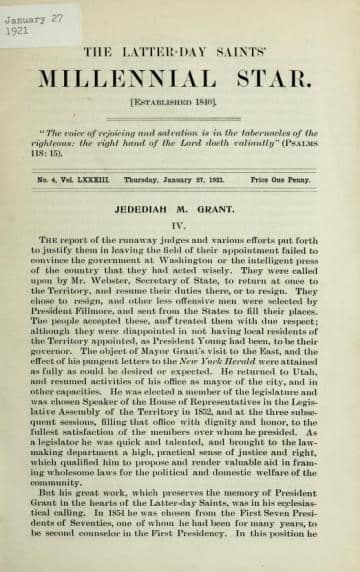Magazine
The Nine Bibles of the World

Title
The Nine Bibles of the World
Magazine
The Latter Day Saints' Millennial Star
Publication Type
Magazine Article
Year of Publication
1921
Authors
Thorgeivson, J. (Primary)
Pagination
60–61
Date Published
27 January 1921
Volume
83
Issue Number
4
Abstract
This article lists nine books that serve as foundations for different religions, or the nine bibles of the world, in which is included the Book of Mormon.
THE NINE BIBLES OF THE WORLD.
The nine bibles of the world are, viz.: the Koran of the Mohammedans, the Eddas of the Scandinavians, the Tripitakas of the Buddhists, the Five Kings of the Chinese, the three Vedas of the Hindoos, the Zend-Avesta of the Persians, the Book of Mormon of the Nephites, the Book of Doctrine and Covenants of the Latter-day Saints, and the Holy Bible. The Koran is since the seventh century of the Christian era, and comprises quotations from the Old and New Testaments, the Talmud and the Gospel of St. Barnabas. The Eddas of the Scandinavians was first published in the fourteenth century. The Tripitakas of the Buddhists contains sublimeinorals and pure aspirations, but their author lived and died in the sixth century B. C. The sacred writings of the Chinese are called the Five Kings, “Kings” meaning web of cloth, or the warp that keeps the threads in their place; they contain the sayings of the best sages on the ethics and political duties of life; these sayings cannot be traced to a higher period than the eleventh century B. C. The three Vedas arc the most ancient writings of the Hindoos, and it is the opinion of Max Miiller, Wilson, Johnson and Whitney, that they are not older than from the eleventh century B. C. The Zend-Avesta of the Persians contains the sayings of Zoroaster, who was born in the twelfth century B. C. Nephi wrote his books, which are the first part of the Book of Mormon, in the sixth century B.C. The Book of Doctrine and Covenants was first published, April 1830. Moses lived and wrote his Pentateuch fifteen centuries B.C.; and the Holy Bible therefore has a clear margin, three hundred years older, than the most ancient of other sacred writings. There is nothing of excellence in any of these sacred books that is not to be found in the Bible, and as a fact, it is the true foundation of all excellent writings, and useful acts.
The Bible is the grandest and most stupendous of all sacred books; it contains three million five hundred and sixty-six thousand four hundred and eighty letters, eight hundred and ten thousand six hundred and ninety-seven words, thirty-one thousand one hundred and seventy-three verses, one thousand one hundred and eighty-nine chapters, sixty-six books. The word “and” occurs forty-six thousand two and twenty-seven times within its lids, the word “reverend,” only once, in the ninth verse of the one hundred and eleventh Psalm. The word “Lord,” one thousand eight hundred and fifty-five times. The middle and least chapter is the one hundred and seventeenth Psalm. About the finest chapter to read is the twenty-sixth of the Acts. The nineteenth chapter of II. Kings, and the thirty-seventh chapter of Isaiah are alike. The shortest verse is the thirty-fifth, eleventh chapter of St. John. The eighth, fifteenth, twenty-first and thirty-first verses of the one hundred and seventh Psalm are alike. Each verse of the one hundred and thirty-sixth Psalm ends alike. There are no words or names in the Bible of more than six syllables.
Jno. Thorgeirson.
Subject Keywords
Bibliographic Citation
Terms of use
Items in the BMC Archive are made publicly available for non-commercial, private use. Inclusion within the BMC Archive does not imply endorsement. Items do not represent the official views of The Church of Jesus Christ of Latter-day Saints or of Book of Mormon Central.